An Annotated Paipo
Interview of William "Bill" Clymer
Adapted from an Oral Interview by Frances Harpur on May 18, 1996. Sydney, Australia.
Sound Recording Interview courtesy of Warringbah Council Library
and with the approval
of his son, Matt Clymer, and daughter, Elizabeth Lewis.
Annotated information and additional research by Bob Green.
Just as surfboard manufacturing was about to take off
with the transition from wood to foam & fiberglass, William "Bill" Clymer
would drop out of the industry and stick with making wooden oars and
surf boats. Clymer would become a name synonymous with building
surf boats, a tradition carried on today by his son, Matt. Bill Clymer not
only made surf boats but rowed them as well. Unbeknownst to most are the bellyboards designed and built by Bill Clymer.
This biographical account of Bill Clymer's surfing and life experiences
is based upon a recorded interview conducted in
1996 by Frances Harpur. It is one of many oral history interviews by
Frances Harpur, which are held by the Warringbah Council Library. The
Harpur interview is supplemented with additional information provided
by Bill Clymer's son and daughter, Matt and Elizabeth, respectively,
and other information obtained in the course of Bob Green's research.
|
1. I'm
speaking with Mr. Bill Clymer and it's Saturday the 18th of May, 1996.
Mr. Clymer would you like to tell me where you were born?
In Melbourne, on the
12th of August 1923.
2. Did you go to school
there?
Yes, I went to
Brighton Grammar, then Melbourne Grammar and finished up at Geelong
Grammar.
How did you eventually become involved in boat
building?
I was building boats when I was at school and selling them - small
boats.
What type of boats were they, sailing boats, rowing
boats?
Sailing boats and rowing boats.
What size?
Designing them. Only small boats. One-man boats, two-man. That sort of
thing.
Bill
Clymer with a finished wave ski, ca. 1958-60.

Photo
courtesy of Matt Clymer and Elizabeth Lewis.
3. Did you have any training
or was it just an aptitude?
It was an aptitude. I was always keen on wood working and tools. And we
had a very good carpentary teacher at Geelong Grammar where I was. He
taught me a lot about the use of tools and so on. I left school when I
was 16. I was no good at schoolwork. The war had started and I knew I
would become involved, sooner or later. So I went to droving in
Queensland with the cattle, to the Northern Territory,down to Bourke in
New South Wales in those years. I did two of those trips and then I
came to Sydney and I lived there for a time and joined up in 1942, when
I was in Sydney. They transferred me to Melbourne, so when I went down
there. I was a VX during the war [see note 1].
When I joined up first I was in the Signals mob. We were posted over to
Western Australia because they considered the Japanese would do as they
had done all through the islands, attack both sides, at once. I'd had
enough of that so I transferred into a commando mob, Z Special Unit. I
was with them 'til the end of the war. Myself and a naval lieutenant
were the last ones to operate the one-man submarines, the "Sleeping
Beauties." Because of the abortive raid
on Singapore, the second raid, they weren't very well known, they were
still on the secret list, highly secret. We were sworn to secrecy about
them. All we did with them in the end was shore reconnaissance because
the American submarines had the Japanese shipping around Borneo and the
Philipines all tied up.
Sleeping
Beauty.
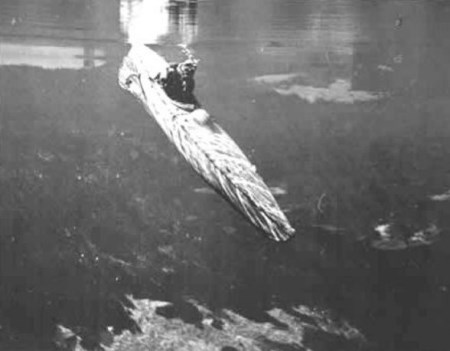
Source: In a report on the Sleeping Beauty Project (Anderson, 2010, p. 1).
After the Sleeping Beauties became redundant I went to the Black Snake,
which was one of the fleet of Snake Boats - all named after snakes. The
most well known one of course, was the Krait, which is now in the
Maritime Museum in Sydney. That was the one that did the first raid on
Singapore. I was on the Black Snake and the naval lieutenant who was in
charge of me, he went on to the River Snake. These were trawler hulls
with a false stern put on them and rigged like a junk but with a Gray
marine diesel in them and an Oerlikon gun, down aft.
These smaller Snake boats were kept going with two larger ones that
supplied them. There was the Anaconda and the Mother Snake. They were
considerably bigger with more crew and more room for supplies. We were
also restocked at various places from drops, from aircraft, storepedoes
as they were called, with food and so on in them.
Black Snake (below left) and
Tiger Snake (below right).
|
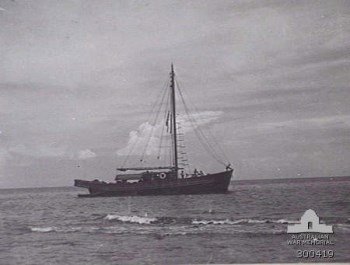 |
|
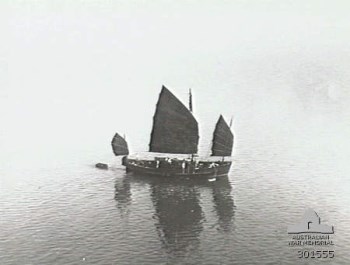 |
Source:
Australian War Memorial, at http://www.awm.gov.au/collection/301555/ and http://www.awm.gov.au/collection/300419/.
After the war ended, after the atomic bomb was dropped, of course, then
we were put on to the strength of the 9th division because the 93
operatives in Borneo that accounted for more Japanese than the 6th, 7th
and 9th divisions combined. So we had to wait and we finally came home
on the Manoora, which was a passenger ship around the Australian coast
that turned into a naval vessel during the war.
I quickly pulled a few strings and got out of the Army quite quickly,
afterwards and started going down to Torquay which is the other side
from Portsea. Not so boisterous a surf, but very big waves just the
same. That's when we started riding the boards and so on then. In those
days, quite long boards, over 16-foot some of them were.
And heavy?
Mainly hollow, which I was making and selling at the time down at
Torquay, and even sending some to Sydney. And making surfboat oars as
well and sending them to Sydney. Eventually my wife and myself decided
that as Sydney was more or less the top place for boat building in
Australia and where all the new ideas and that came from, that it would
be more advantageous if we moved there, which we did in 1957.
Bill
with a half made racing surf ski, ca. 1958-1960.
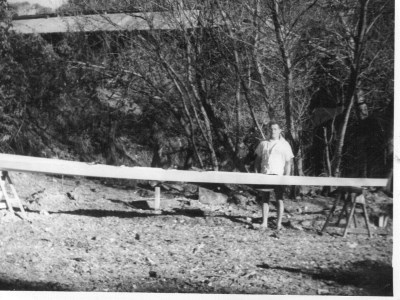
Photo
courtesy of Matt Clymer and Elizabeth Lewis.
I found a little factory in Manly Vale and it backed right onto the old
tip, that was there at the time. I had over six months work in front of
me all the time making surf boat oars so I couldn't do anything else
at the time. But I'd still make the hollow, shortboards then, that had
come in. They came into Australia because in 1956, when the Olympic
Games were in Melbourne, the Americans brought out these shortboards
and we saw how much more manoeuvrable and more fun they were than the
old boards that we virtually only just came straight in on. After these
hollow ply ones which we made, some balsa became available and we found
out straight away that it was far a better medium than the hollow
boards which tend to bounce, especially coming down on a large wave. If
there was a bit of chop there it would throw you off. That was the
start of the balsa industry. There was Gordon Woods, myself, several
others who started making those shorter boards.
Matt Clymer and Elizabeth Lewis with some plywood surf ski's and long boards built by Bill Clymer,
ca. 1960.
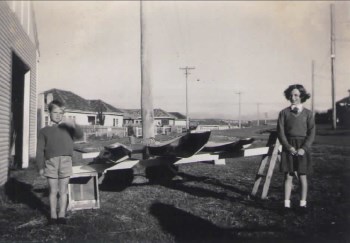
Photo
courtesy of Matt Clymer and Elizabeth Lewis.
4. Mr. Clymer, as this was
an infant industry were there many people involved?
Not very many in the
early days. There was Gordon Woods, Bill Wallace and myself, were the
main ones. There was Roger Kieran. He was the first one to build a
balsa board, but after we discovered that the balsa was a far better
thing everybody got the balsa. At one stage I was possibly the biggest
builder of surfboards in Australia, but only for a short time. Then
they became blonding their hair and smoking the marijuana. About this
time the foam starting coming. When the foam medium of making the
boards came in I left the industry altogether and concentrated on the
oars and subsequently started making the surf boats.
Clymer
bellyboard. Matt Clymer advises that "the first one was 3-foot long and
was a similar shape to the later ones he made in the photos. The later
ones were about 4-foot long for better performance—more buoyancy."
|
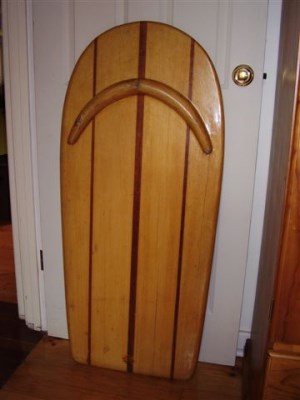
|
|
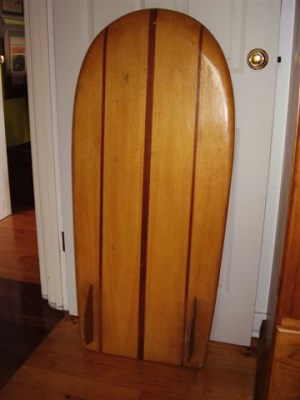
|
Photo
by Mike Brown.
Clymer
bellyboard fins and logo.
|
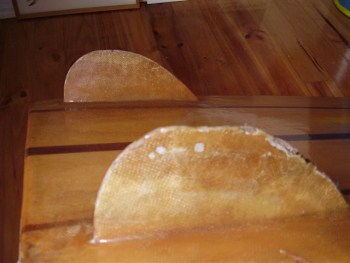
|
|
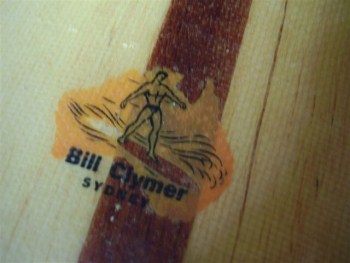
|
Photo
by Mike Brown.
Clymer
bellyboard and logo. Matt Clymer said the red wood was most likely
cedar as Bill was something of a cedar fanatic.
|
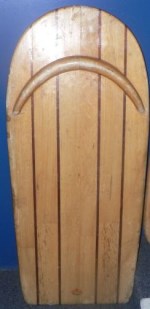 |
|
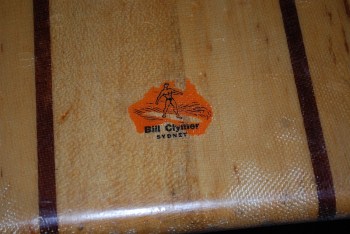
|
In a paipo
interview, Joe Larkin noted, "Bill Clymer used mainly Australian red
cedar in boards as he used it in boats and it really is much stronger
and better color than California western red cedar. We used draw knives
when doing balsa boards in the early days. Bill used adzes for blades
on sweep oars and he also made up wood with a Try plane of about
20-inches-long with concave bottom for doing shafts of oars. It is a
long-based plane that is used to get timber straight. Nowadays they use
electric jointer machines." (Bob Green paipo interview with Joe Larkin, 2013)
Photos courtesy of Surf World Museum,Torquay, Australia.
5. Did you export any boats
overseas when you made the surf boats. Did you export them to any other
county?
We've sent quite a
few over the years to South Africa, one or two to New Zealand. I think
they make their own there now. I think there is one or two of our boats
in England, even
Is there a different wood used in different countries,
or is the same wood used to make the boats?
Well as far as I know, there has never been an Australian style surf
boat made anywhere in the world, except Australia. They do have those
wooden dories that they paddle with sort of a canoe type paddle, in the
States. I think they may have oars, some of them, but they're entirely
different.
You said you didn't know the reason for Australian
surf boat being different?
The Australian surf boat evolved. The first real one that came—we have
these old pictures of the Sly Brother of Manly. But they weren't real
surf boats, they were fishing boats. The first real surf boat that came
to Australia was designed on a Norwegian lifesaving boat. They were 18-foot
long and eventually old Fred Notting, who is long since dead, from
Manly, designed one with four thwarts [see note 2].
Before that two people sat in the midship thwarts with one with an oar
out one side and an one out the other. Then there was the bow and the
stroke. But then that necessitated making the boats longer and then
they finished up 22 feet, 6 inches long rather than 18-foot. Eventually they got longer
because people wanted them to go quicker. Then the tuck stern was
introduced by a boat builder up in Newcastle, Tom Humphries. Eventually
they reached 26-foot which they are today. The Surf Life Saving Association
then disallowed them to be made any longer or any narrower, with less
freeboard than they have now.
Bill's
first surfboat, 1964.
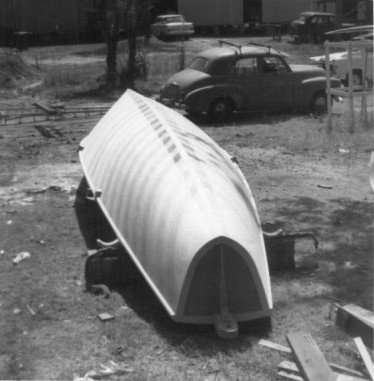
Photo courtesy of Matt Clymer and Elizabeth Lewis.
6. Was the surf boat used for
club prestige in carnivals or was it really effective in surf rescue?
The surf boat was of
course the only rescue medium other than surfboards and surf skis in
the early days, or up until recently. Of course, now they are supplanted
really by rubber duckies and helicopters, and those sort of things. But
now the tradition of racing them has kept going. The same could be said
for the surf skis, which are narrow, long and skinny and not very good
for life saving but they still keep going and keep the people fit in
the surf clubs.
Bill Clymer in
surf boats.
|
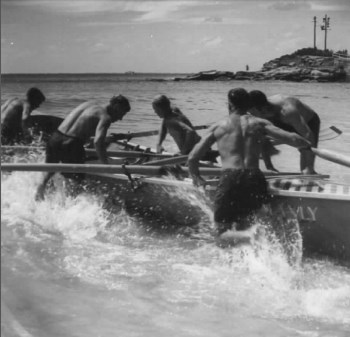 |
|
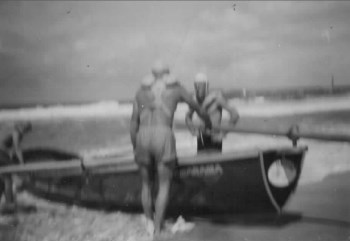 |
Photos
courtesy of Matt Clymer and Elizabeth Lewis.
So is the beltman only used for single rescues?
The beltman, of course, has gone out altogether now. They've proved
that taking the belt though the water has killed more people than it
has saved.
Too dangerous.
Too dangerous, if the line gets caught under rocks. That's the end of
the poor beltman.
7. Which surf clubs have you
been personally involved with along the foreshore?
Well, I was a member
of Manly ever since I came back to Sydney. But my first sweeping of a
surfboat in Sydney was at North Bondi. I was a friend with the
legendary "Spaz" Hurst and he was sweeping the 'A' crew there and I was
sweeping the 'B' crew for a year. We won more races than any other 'B' crew
in that particular year that I was there. As a matter of fact, the crew
that I trained there, "Spaz" Hurst said there was an 'A' crew up in
Mooloolaba and I won the Australian with them. After that I was back in
Manly because the sweep at Manly, Johnny Windshuttle had a scuffle with
the president, so he was given the boot and they had nobody, so I had
to go and sweep the boat at Manly. I was two years at Manly. We got in
the Australian final both years. One was a big sea at Merewether and
the next year was the still water down in South Australia, At Moana.
Then Queenscliff asked me to go down there. I'd given over my sweeping
at Manly to the younger people and so I went and started them, and
eventually they won an Australian title with the crew I started witht
Queenscliff. [See note 3.]
8. Since that time you've
watched some of our younger surfers become internationally well known.
How were you involved with that besides the manufacturing?
I was always keen on
board riding myself and in those early days, Midget Farrelly and all
those people, I was up with that. I think it was the second board
contest that they held in Australia that I was a judge with Gordon
Woods and I can't remember the third bloke. The three of us would go
together and give so many points for each ride that the board riders
had on the waves.
Bill
was a judge at this competition. He also made many of the boards.
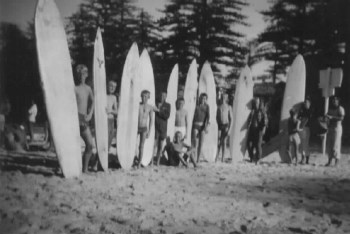
Photo courtesy of Matt Clymer and Elizabeth Lewis.
No sponsors in those days?
No sponsors in those days.
Why could they be managed then with no sponsor?
Well, I don't know.
No prize money?
Old Snow McAlister used to put up a few signs saying "Board Contest
here" and so on and the crowd would turn up, righto, and off you go.
What year was that?
That would be 1962 or 1963, around about that. I'm not much on times.
That's alright, that just gives an idea. What year did
sponsorship begin?
I really don't know. As I say, I left the surfboard industry and became
involved making the surf boats and oars, and I really didn't take much
notice what happened with the board riders after that, as far as
competition goes and sponsorships and so on. I still kept riding the
boards myself until recent years.
Snow McAlister
commissioned BIll Clymer to build a replica of Sprint Walker's 1920s
board.
|
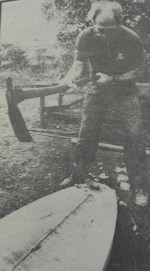
|
|
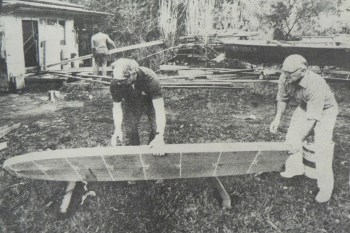
|
McAlister, Snow. (1974, October). Sprint Walker ... he buried his
board in the sand. Tracks
Magazine, 49, p.21.
Whereabouts did you ride?
Anywhere. I used to go out with old Snow McAlister a bit, out White
Rock. White Rock on Long Reef, on the Collaroy side there. How it stays
white, I don't know, no barnacles cling to it. Which is strange. How
the hell did it get there.
In these competitions which you held, how many
competitors would there have been?
Well it did vary of course, generally speaking, only about 20.
Were they all local or did they come from Australia-wide?
I'd say about all around here, the northern beaches and from the Sydney
area. Tamarama, Bondi and so on.
Fairly young?
Fairly young people, some getting on a bit.
What do you call getting on?
Some of them like Bluey Mayes and those notable characters that were
35, 40.
Bluey
Mayes with two bellyboards in the foreground. One of the bellyboards is believed to be
owned by Leigh Tingle. This board was made by Gordon Woods in 1958.
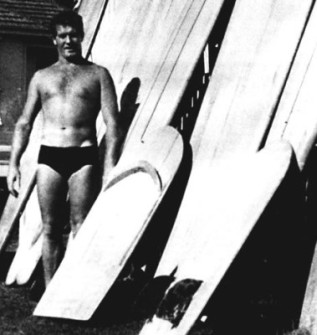
Photo courtesy John Sullivan and Dan Webber, on-line at Bondi
Stories.
Were there any girls competing in those days?
None that I can remember competed and there were very few girl board
riders. I can only remember one, down at Manly—Judy Cameron. She was
be the only one I can think of at the moment who got out on the boards
at all.
Well these days, of course, they have contests for the
women and for the males. Do you ever think that they ever will compete
in the same competition, against one another?
I doubt very much. The men are more aggressive board riders and
thinking of new ways, reentries and all that. Pretty old hat, the girls
even do that now. They're some fantastic tricks now, the male board
riders. I can't see, at this stage that they would compete against one
other.
9. Have you ever had that
adrenalin rush of being pushed to the absolute limit?
Yes, it's a great feeling. One time that I can remember was at
Merewether, in the Australian there. In the heat we had some very good
crews against us. We turned the boat buoys first and we came in and
this huge wave came in. I said, "We'll have this one," and we rowed, and
then somehow the wave greened off and I said, "Touch her away hard." And
then we were almost vertical when we got on it and rowed it to the
beach. It was a fantastic wave. I turned around and all the rest of the
crews were just turning the buoys.
Another time. I had been working. It was a Saturday and a girl was over
from Melbourne staying with Shirley, my wife. And we went to the
Harbord Hotel for a drink and glancing down the road I could see there
was a huge surf on. So I said, "Let's go down and look at this." When
we got down there, my friend Brian O'Callagan, was rubbing down a boat
behind the boatshed. So I said, "What are you doing here, the waves are
out there?" So he said, "Come on." So we got three juniors—one was
Zombie Knox—I can't remember the other two. We finally got out at the
northern point, it took us quite some time. In the meantime, Bill
Marsh, who is Kim Marsh's father, he had a movie camera and he came
along positioned himself up along, outside Harbord Diggers and filmed
us on this huge wave. It had three big steps on it and Brian
O'Callaghan handled the boat very well and she came down the third step
and the wave broke and the boat broke, right down the middle. An oar
popped up near me, I was running out of breath at the time, so I
grabbed hold of the oar and I was first to reach the beach.
Brian
O'Callagan sweeps Miss Astor not long before she breaks, ca. 1964.
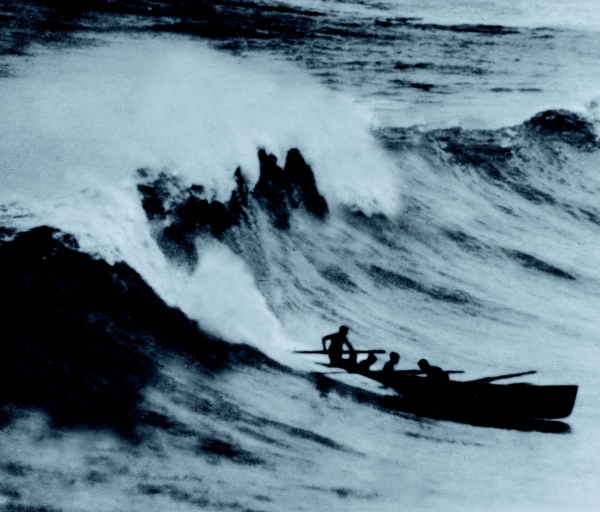
Courtesy of the Freshwater Surf Life Saving Club. See the Freshwater website, at http://www.freshwaterslsc.com/galleries/category/history/236.
So you didn't have any casualties?
No casualties, nobody hurt, except the boat.
That was a big loss then.
So I got home. The children came running out. They said, "Guess what,
the 2SM shark plane just reported that the Freshie cracked a big wave
and that the boat has broken in half." And I said, "Yeah and here is
the seat that I sat on."
10. Is there anything that you have considered a first?
We could have been the first ones to have cracked Bells Beach in
Victoria, about 2 or 3 miles along the coast from Torquay. We rowed the
surfboat around there and cracked quite a big wave. It's a pretty hairy
ride in a surfboat cause you've got to go hard right, otherwise you
finish on the rocks. We managed to go through the top of the wave
without landing on the sand, on that particular time. Whether we were
the first ones or not I'm not quite too sure. There were two ski
paddlers down there, Owen Yateman and Brian Begg. They were about the
same time. Whether they were first or we were first in the surfboat, I
don't know.
11. Do you think the type of
person that's been interested in the surfboards, surfing and the
competition involved has changed much over the years?
Basically these are people who love the sea and the surf.
Other information
The interview continues for another 8-1/4 minutes, covering a range of
topics including: how the northern beaches compare to the rest of the
world, dune regeneration, the decrease in shark fatalities and shark
stories, the mistake the Surf Life Saving movement made not accepting
surfboards and the decline in surf club participation, and the "surfie"
image improving.
Matt Clymer has provided addiitional information about his father: "...
his parents were
Americans. James Clymer was from Chicago and Dorothy Reimer Clymer
hailed from California. Bill was born in good old Australia. Father was
also a fanatical skier. He skied before the War at Mt. Hotham
and travelled to Steamboat Springs, Colorado, every year until about
2000. Dad was a Life Member of Manly Life Saving Club and is also in
the Hall of Fame of the Australian Surfboat Rowers League."
Bill died in 2004. Clymer Boats is operated out of Brookvale, by Bill's
son, Matt.
Note 1. VX indicated that
Victoria was his state of birth. Elizabeth Lewis told me, "Dad always said he enlisted at Manly (office near old
tram shed, now Harris farm) then returned to Melbourne and went into a
Melbourne unit."
(Elizabeth Lewis, personal e-mail, May 22, 2013)
Note 2. "Thwarts" is a term
used for the cross-structural part of a boat. (Matt Clymer, personal e-mail. May 22,
2013)
Note 3.
Besides making surf boats and oars, Bill Clymer put in many hours
competing and training. Pollard (1996) refers to Bill (Social) Clymer
as very dedicated to the Torquay Surf Life Saving Club. He joined the
club in December 1950, and was a member of boat crews who won Victorian
titles from 1953 to 1955. Bill was boat captain from 1955 to 1957. The
crews of these boats are reported to have rowed "marathon" distances in
the southern ocean for training. Pollard also reports the boats were
often stored at Bill's home in Brighton and training would occur in Port
Phillip Bay, "They would often arrive home in the dark, cold, tired and
hungry, use all of Bill's hot water showering, eat all the food his
wife Shirley prepared and more, then proceed to drink all his beer." No
wonder he was described as having a "short fuse." He resigned from the
club in May 1957, to relocate to Sydney and was reported to have swept
boats for Bondi clubs for many years.
Bibliographic Sources
Anderson, Ross. (2010, April). Motorised Submersible Canoe (MSC) "Sleeping Beauty" Project (Rep. No. 261). Department of Maritime Archaeology, Western Australian Museum. Retrieved from [link].
Clymer, Bill. Biographical information on Bill Clymer, is available
in his own words. Source: Bill Clymer [sound recording] / interviewed
by Frances Harpur. Dee Why - Local Studies LS CD 994.41 Interview date:
18 May 1996. Warringah Library Service oral history interview project.
Green, Bob. (2013, May). A Paipo Interview with Joe Larkin: Surfboard craftsman from wood to foam. On the Internet at MyPaipoBoards.org.
Pollard, Ken. (1996). History of Torquay Surf Life Saving Club: The first fifty years, 1945-1995. Torquay, Vic: Torquay Surf Life Saving Club.
|
I am aware that some of the images and other content on this website may be subject to copyright and
will gladly remove any such items if so requested by the genuine holder
of the rights. Such content is not used for commercial exploitation. The sole purpose is to share knowledge with enthusiasts and interested parties. To the extent possible copyright holders have been contacted for permission to share content on this website. Likewise please respect the copyright content of this site.
|
All
contents of this site ©1998-2025 Rod's Home Port
for SurfMarks and MyPaipoBoards.
All
images within this section copyright of
respective
credited contributor.
|
|
Last updated on: 06/12/13
|



















